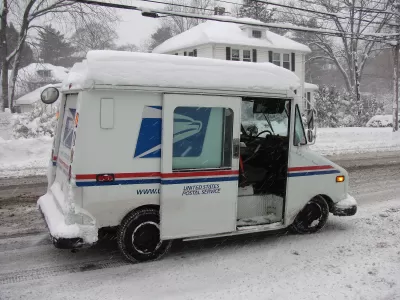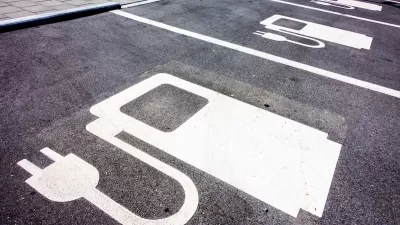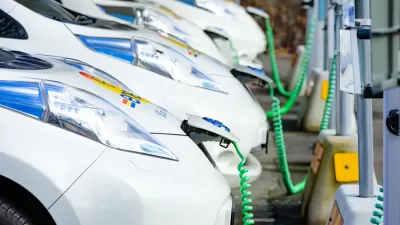Critics say the Postal Service's argument for its weak commitment to electrifying its vehicle fleet doesn't hold water.

Despite a mandate to electrify federal agency vehicle fleets by 2035, the U.S. Postal Service is only committing to replacing 10 percent of its delivery trucks with electric vehicles, a minimal pledge that sustainability advocates deem unacceptable. While the USPS revealed new, pedestrian-friendly truck designs last year, it appears most of them will still run on gas. As Kea Wilson reports, the agency, which operates the largest government-owned vehicle fleet in the nation, is citing financial and logistical challenges.
The agency claims that it would be difficult to keep EV batteries charged during long mail routes, but the Natural Resources Defense Council (NRDC) rejects this argument, pointing out that "fewer than 6 percent of U.S. mail routes are longer than 70 miles, while today’s electric cargo vans can already go 140 miles on a charge — a capacity that’s likely to go up as battery technology improves."
According to the article, linked below, the agency also fails to mention the possibility of introducing electric cargo bikes or tricycles for mail delivery in dense urban areas, despite their potential to slash emissions and cost. Advocates tout the environmental, financial, and public health benefits of switching to electric bikes and trikes where appropriate.
FULL STORY: RETURN TO SENDER: USPS Decarbonization Plan is Weak, Say Advocates

Study: Maui’s Plan to Convert Vacation Rentals to Long-Term Housing Could Cause Nearly $1 Billion Economic Loss
The plan would reduce visitor accommodation by 25,% resulting in 1,900 jobs lost.

Placekeeping: Setting a New Precedent for City Planners
How a preservation-based approach to redevelopment and urban design can prevent displacement and honor legacy communities.

Using Old Oil and Gas Wells for Green Energy Storage
Penn State researchers have found that repurposing abandoned oil and gas wells for geothermal-assisted compressed-air energy storage can boost efficiency, reduce environmental risks, and support clean energy and job transitions.

Washington State Plans Ambitious ‘Cycle Highway’ Network
The state is directing funding to close gaps in its existing bike network and make long-distance trips more accessible.

Homeowners Blame PG&E for Delays in ADU Permits
The utility says it has dramatically reduced its backlog, but applicants say they still face months-long delays for approvals for new electrical work.

Rethinking Wildfire Defense: How a Landscape Approach Can Protect Neighborhoods
Post-fire analysis of the Eaton Fire reveals that a landscape approach — including fire-resistant vegetation, home hardening, and strategic planning — can help reduce wildfire risk, challenging assumptions that trees and plants are primary fire hazards.
Urban Design for Planners 1: Software Tools
This six-course series explores essential urban design concepts using open source software and equips planners with the tools they need to participate fully in the urban design process.
Planning for Universal Design
Learn the tools for implementing Universal Design in planning regulations.
Borough of Carlisle
Caltrans
Heyer Gruel & Associates PA
Institute for Housing and Urban Development Studies (IHS)
City of Grandview
Harvard GSD Executive Education
Salt Lake City
NYU Wagner Graduate School of Public Service
City of Cambridge, Maryland





























